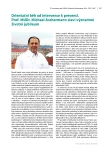-
Medical journals
- Career
Obesity and heart
Authors: Štěpán Svačina
Authors‘ workplace: III. interní klinika 1. LF UK a VFN Praha, přednosta prof. MUDr. Štěpán Svačina, DrSc., MBA
Published in: Vnitř Lék 2014; 60(12): 1068-1071
Category: 70. birthday prof. MUDr. Michael Aschermann, DrSc., FESC, FACC
Overview
Cardiovascular complications of obesity are traditionally considered an important complication of obesity. Obesity itself is probably not direct cause of atherosclerosis or coronary heart disease. This may occur indirectly in metabolic complications of obesity, especially diabetes and metabolic syndrome. However, thrombogenicity potential of obesity contributes to embolism and atherosclerosis development. In cardiology is well-known a phenomenon of obesity paradox when obese patients have better prognosis than thin. This is the case of heart failure and some other cardiovascular diseases. Recently, a new concept has emerged of myokines – hormones from muscle tissue that have extensive protective effects on organism and probably on heart. Whether heart is a source of myokines is uncertain. However, undoubted importance has epicardial and pericardial fatty tissue. The epicardial fatty tissue has mainly protective effects on myocardium. This fatty tissue may produce factors of inflammation affecting the myocardium. Relationship between amount of epicardial fatty tissue and coronary heart disease is rather pathogenic. Currently, it is certain that obesity brings more metabolic and cancer complications than cardiovascular and accurate contribution to pathogenic or protective character of fatty tissue in cardiology requires further research. Nevertheless, the conclusion is that adipose tissue of organism and around the heart may be in some circumstances beneficial.
Key words:
adipokines – complications of obesity – epicaridal fatty tissue – myokines – obesity paradox – pericardial fatty tissue
Sources
1. Ardestani A, Hoffman HJ, Cooper HA. Obesity and outcomes among patients with established atrial fibrillation. Am J Cardiol 2010; 106(3): 369–373.
2. Artham SM, Lavie CJ, Milani RV et al. Obesity and hypertension, heart failure, and coronary heart disease-risk factor, paradox, and recommendations for weight loss. Ochsner J 2009; 9(3):124–132.
3. Cherian S, Lopaschuk GD, Carvalho E. Cellular cross-talk between epicardial adipose tissue and myocardium in relation to the pathogenesis of cardiovascular disease. Am J Physiol Endocrinol Metab 2012; 303(8): E937-E949.
4. Isomaa B, Almgren P, Tuomi T et al. Cardiovascular morbidity and mortality associated with the metabolic syndrome. Diabetes Care 2001; 24(4): 683–689.
5. Jee SH, Sull JW, Park J et al. Body-mass index and mortality in Korean men and women. N Engl J Med 2006; 355(8): 779–787.
6. Kim TH, Park J, Park JK et al. Pericardial fat volume is associated with clinical recurrence after catheter ablation for persistent atrial fibrillation, but not paroxysmal atrial fibrillation: An analysis of over 600-patients. Int J Cardiol 2014; 176(3): 841–846.
7. Lainscak M, von Haehling S, Doehner W et al. The obesity paradox in chronic disease: facts and numbers. J Cachexia Sarcopenia Muscle 2012; 3(1): 1–4.
8. Mahabadi AA, Lehmann N, Kälsch H et al. Association of epicardial adipose tissue with progression of coronary artery calcification is more pronounced in the early phase of atherosclerosis: results from the Heinz Nixdorf recall study. JACC Cardiovasc Imaging 2014; 7(9): 909–916.
9. Pedersen BK. Muscle as a secretory organ. Compr Physiol 2013; 3(3): 1337–1362.
10. Reis JP, Allen N, Gibbs BB et al. Association of the degree of adiposity and duration of obesity with measures of cardiac structure and function: The CARDIA Study. Obesity (Silver Spring) 2014; 22(11):2434–2440.
11. Roberts LD, Boström P, O’Sullivan JF et al. β-Aminoisobutyric acid induces browning of white fat and hepatic β-oxidation and is inversely correlated with cardiometabolic risk factors. Cell Metab 2014; 19(1): 96–108.
12. Shaw KA, Edelman AB. Obesity and oral contraceptives. Best Pract Res Clin Endocrinol Metab 2013; 27(1): 55–65.
13. Svačina Š. Obezitologie a teorie metabolického syndromu. Triton: Praha 2013. ISBN 978–80–7387–678–4.
14. Walsh K. Adipokines, myokines and cardiovascular disease. Circ J 2009; 73(1): 13–18.
15. Yamada H, Sata M. The role of pericardial fat: The good, the bad and the ugly. J Cardiol 2014; pii S0914–5087(14)00203–2. Dostupné z DOI: <http://dx.doi.org/10.1016/j.jjcc.2014.07.004>.
Labels
Diabetology Endocrinology Internal medicine
Article was published inInternal Medicine

2014 Issue 12-
All articles in this issue
-
Orienteering from intervention to prevention.
Prof. Michael Aschermann celebrates life jubilee - Prof. Michael Aschermann, MD, DSc, FESC, FACC, life jubilee
- Anticoagulant therapy in secondary prevention of coronary events
-
Anaemia and iron deficiency in clinical practice:
from cardiology to gastroenterology and beyond - Embolic ischemic strokes
- Will the new SGLT2 inhibitor empagliflozin help us reduce the risk of hypoglycemia?
- Past and present issues of the pulmonary circulation in the General University Hospital in Prague
- Catheter ablation of focus triggering ventricular fibrillation in patients with structural heart disease
- Current status of intravascular ultrasound in interventional cardiology
- Obesity and heart
- Carotid artery stenting – history, trends and innovations
- Do natriuretic peptides have a new chance in treatment of heart failure?
-
Renal denervation in patients with resistant hypertension:
is it still possible to resuscitate? - Modern treatment of acute ischemic stroke
- Percutaneous approach for treating mitral regurgitation with mitral clip (MitraClip)
- IMProved Reduction of Outcomes: Vytorin Efficacy International Trial (studie IMPROVE-IT)
-
Orienteering from intervention to prevention.
- Internal Medicine
- Journal archive
- Current issue
- Online only
- About the journal
Most read in this issue- Percutaneous approach for treating mitral regurgitation with mitral clip (MitraClip)
-
Anaemia and iron deficiency in clinical practice:
from cardiology to gastroenterology and beyond - Embolic ischemic strokes
- Obesity and heart
Login#ADS_BOTTOM_SCRIPTS#Forgotten passwordEnter the email address that you registered with. We will send you instructions on how to set a new password.
- Career

